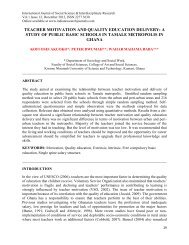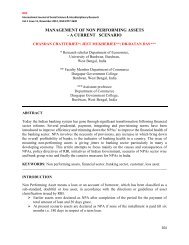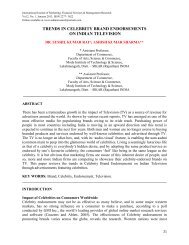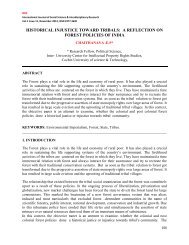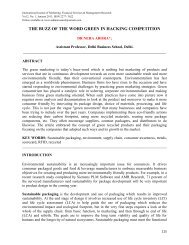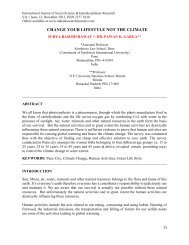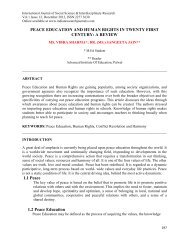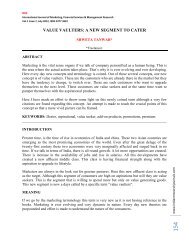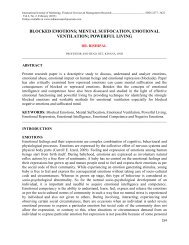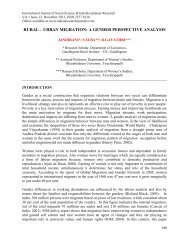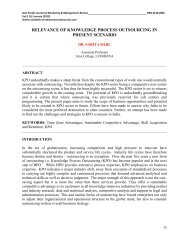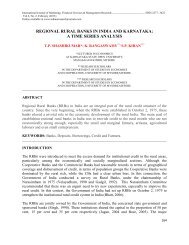problems and prospects of small scale industrial units
problems and prospects of small scale industrial units
problems and prospects of small scale industrial units
Create successful ePaper yourself
Turn your PDF publications into a flip-book with our unique Google optimized e-Paper software.
IRJC<br />
Asia Pacific Journal <strong>of</strong> Marketing & Management Review<br />
Vol.1 No. 2, October 2012, ISSN 2319-2836<br />
Sukhpal Singh (2001) in his article on “employment, Efficiency <strong>and</strong> Entrepreneurship in <strong>small</strong><br />
industry: A study <strong>of</strong> the baking industry in Punjab” examines some aspects <strong>of</strong> <strong>small</strong> industry in<br />
context <strong>of</strong> the secondary food processing consumer industry <strong>and</strong> the baking industry in Punjab.<br />
The <strong>small</strong> industries are today, viewed as inefficient, highly capital intensive <strong>and</strong> outdated in<br />
terms <strong>of</strong> production, technology <strong>and</strong> consequently products. The <strong>small</strong> <strong>scale</strong> baking industry also<br />
exhibits low productivity. This industry, as such, is efficient compared to large <strong>scale</strong> sectors <strong>of</strong><br />
the industry. This article looks at the emergence, growth, structure <strong>and</strong> unregistered sector. It<br />
also attempts to assess the present <strong>and</strong> potential role <strong>of</strong> these <strong>units</strong> in the development <strong>of</strong> local<br />
economy <strong>and</strong> tries to draw a policy framework for the development <strong>of</strong> <strong>small</strong> <strong>scale</strong> sector.<br />
The present study is step further to develop sufficient insight leading to formation <strong>of</strong> appropriate<br />
institutional arrangement to strength economic viability <strong>of</strong> <strong>small</strong> <strong>scale</strong> <strong>industrial</strong> <strong>units</strong> in Haryana<br />
<strong>and</strong> else where in country This study will provide essential guidelines to planners, policy makers,<br />
administrators <strong>and</strong> exporters. This will also assist to entrepreneurs to be cautious in planning,<br />
erecting <strong>and</strong> managing their <strong>units</strong>. It also forces the SSI entrepreneurs to enter in world wide<br />
business, so as to avoid common pitfalls resulting dreaded <strong>industrial</strong> sickness.<br />
OBJECTIVES OF THE STUDY<br />
The proposed study is primarily aimed at bringing out the <strong>problems</strong> <strong>and</strong> <strong>prospects</strong> <strong>of</strong><br />
<strong>small</strong> <strong>scale</strong> <strong>units</strong>. Specifically, the objectives are stated as under:-<br />
o To examine the policies <strong>and</strong> practices relating to <strong>small</strong> <strong>scale</strong> <strong>industrial</strong> <strong>units</strong>.<br />
o To find out the differences between <strong>problems</strong> <strong>and</strong> <strong>prospects</strong> <strong>of</strong> exporting <strong>and</strong> nonexporting<br />
<strong>units</strong> followed by them.<br />
o To identify the gaps in those practices which have failed to receive acceptance;<br />
<strong>and</strong><br />
o To specify the <strong>problems</strong> in the existing practices <strong>of</strong> exporting <strong>and</strong> non exporting<br />
<strong>units</strong>.<br />
RESEARCH METHODOLOGY<br />
The present study has adopted descriptive research design. It has taken into account the<br />
survey <strong>and</strong> analysis <strong>of</strong> data <strong>of</strong> a cross section <strong>of</strong> sampling frame. Multi stage r<strong>and</strong>om sampling<br />
method has been used in the study to select sample <strong>units</strong>. First <strong>of</strong> all, on the basis <strong>of</strong> district <strong>and</strong><br />
number <strong>of</strong> <strong>small</strong> <strong>scale</strong> <strong>units</strong> in Haryana, State divided into two zones- low <strong>industrial</strong> develop<br />
zone <strong>and</strong> high <strong>industrial</strong> develop Zone. Under low <strong>industrial</strong> develop zone- Kaithal, Kurukshetra,<br />
Karnal, Jind <strong>and</strong> Panchkula are considered. While Faridabad, Gurgaon, Ambala, Yamuna Nagar<br />
<strong>and</strong> Panipat are taken as a representative <strong>of</strong> high <strong>industrial</strong> develop zone on the basis <strong>of</strong> r<strong>and</strong>om<br />
sampling. At first stage 5 District from each Zone were selected r<strong>and</strong>omly. At the second stage<br />
sample <strong>of</strong> 240 non-exporting <strong>units</strong> <strong>and</strong> 60 exporting <strong>units</strong> were r<strong>and</strong>omly selected. However, 50<br />
<strong>units</strong> were closed among 2003 to 2005. So, fresh selection had to make from the respective<br />
categories to make for the deficiency.<br />
197<br />
www.indianresearchjournals.com



